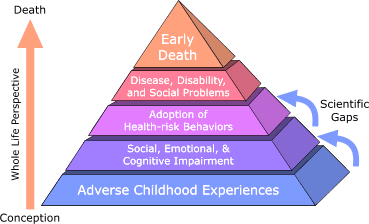ACEing Nutrition
 As I have slowly (but surely!) settled into my role as a nutrition health educator at two Heartland Health Center community clinics,'What do you do?" is a very common question I answer on the daily. Given that my position title gives away a general idea of what I do, one would think it would be easy to explain what I do. However, providing health education for any community, regardless of social identities, requires the acknowledgement and consideration of Adverse Childhood Experiences, (known as ACEs).
As I have slowly (but surely!) settled into my role as a nutrition health educator at two Heartland Health Center community clinics,'What do you do?" is a very common question I answer on the daily. Given that my position title gives away a general idea of what I do, one would think it would be easy to explain what I do. However, providing health education for any community, regardless of social identities, requires the acknowledgement and consideration of Adverse Childhood Experiences, (known as ACEs).
One of the most important and eye-opening training sessions I attended with my host site, Heartland Health Centers, was about incorporating and prioritizing ACEs in our role as health educators.
The CDC-Kaiser Permanente ACE Study, conducted from 1995-1997, looked at 17,000 patients in California, making it one of the largest studies looking at the relationship between later-life experiences and childhood abuse and neglect. According to the study, an ACE happens under the age of 18; it is categorized as either any type of abuse (emotional, physical, sexual), neglect (emotional, physical), or household challenges (violence, family member mental illness, divorce, imprisonment, substance abuse). Results were very strong, and have been replicated with different populations across the country: 2 out of 3 participants reported at least one ACE, and 1 in 5 reported 3 or more. There was a strong positive correlation with the number of ACEs a participant had experienced, as well as the severity of the ACE, relating to increased risk of negative health outcomes such as STIs, mental illnesses, chronic disease such as heart disease and diabetes, poor financial outcomes, fetal deaths, and other health conditions.
When I was first asked to read and become familiar with this pivotal study, I was surprised that I had not heard of this study, let alone known the term'ACE." Why has this pivotal study in public health been so overlooked for so long? More importantly, how can health care professionals provide better services to the communities served?
Hence, although I came in with previous awareness of health disparities and food insecurities in the communities that I serve, I have started to see why the ACE study is often overlooked or unheard of. As providers in serving the underserved, almost every single one of the patients I have seen for 1-on-1 nutrition counseling has at least one ACE, if not multiple. When it is one, it can sometimes be easier to identify through conversation or displays of mental struggle. However, as many of these ACEs add up overtime, it is incredibly difficult to identify or recognize how ACEs have manifested or shaped a person's health experiences. The invisible nature of ACEs contributes to its lack of being integrated in traditional clinic settings.

Regardless of the difficulty, I keep this study in mind every day at the clinics I work at, as Heartland Health Centers is a Federally Qualified Health Center (FQHC)- these institutions receive grant money from the government because they serve typically underserved areas and provide sliding fee scales. FQHCs like Heartland also are committed to high levels of quality in care, as well as patient-centered decision making and services. I believe the benefits outweigh the costs of extra time and resources taken to address a patient's ACEs, especially in the context of nutrition and chronic disease management. ACE studies continue to show the direct relationship between ACEs and obesity and other chronic conditions. They also have shown me how invaluable it is to take time to inquire and provide suggestions and resources that address the roots of one's diet and exercise situations.
Learning about ACEs has so far been the most incredibly useful and beneficial component in addressing nutrition and chronic disease management goals with the HHC patient community. For example, many patients I see have forms of chronic stress due to family situations and often use food not only as a coping mechanism; their bodies also respond to and absorb nutrients less efficiently in states of stress and trauma. In addition, ACEs often manifest in disorderly eating, hopelessness, and other factors that contribute to not only decreased motivation to seek healthier lifestyles but also physical barriers such as not being able to leave one's residence and lack of transportation, among other financial concerns.
Taking the time to engage in active and attentive listening and affirmation of every individual's background information is one of the most valuable tools and skills I have learned through ACE training and daily experiences with patients. When addressing and unpacking ACEs- anything from making a phone call check in when a patient can't come in, to providing other social services to accompany nutrition counseling- resources are saved and utilized more effectively and efficiently. In turn, patients may start seeing increased progress towards their health goals, while providers and healthcare systems may see an increased quality of care, resources, and patient satisfaction. I hope to continue to deepen my understanding of how ACEs impact the prevalence and treatment of obesity and chronic diseases. This service term I hope to augment efforts in combating the immense impact of systemic injustices and traumatic childhood experiences that are often overlooked in nutrition and chronic disease.
This blog post was written by NHC Chicago 2016-17 member Thamara Subramanian.
Thamara is the Health Promoter at Heartland Health Centers - Lincoln Square and Albany Park.